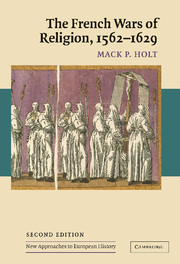Book contents
- Frontmatter
- Contents
- List of maps and figures
- Acknowledgements
- Preface to the Second Edition
- Chronological table of events
- Introduction
- 1 Prologue: Gallicanism and reform in the sixteenth century
- 2 ‘The beginning of a tragedy’: the early wars of religion, 1562–1570
- 3 Popular disorder and religious tensions: the making of a massacre, 1570–1574
- 4 The rhetoric of resistance: the unmaking of the body politic, 1574–1584
- 5 ‘Godly warriors’: the crisis of the League, 1584–1593
- 6 Henry IV and the Edict of Nantes: the remaking of Gallicanism, 1593–1610
- 7 Epilogue: the last war of religion, 1610–1629
- 8 Conclusions: economic impact, social change, and absolutism
- Genealogical charts
- Brief biographies
- Suggestions for further reading
- Index
- NEW APPROACHES TO EUROPEAN HISTORY
5 - ‘Godly warriors’: the crisis of the League, 1584–1593
Published online by Cambridge University Press: 05 June 2012
- Frontmatter
- Contents
- List of maps and figures
- Acknowledgements
- Preface to the Second Edition
- Chronological table of events
- Introduction
- 1 Prologue: Gallicanism and reform in the sixteenth century
- 2 ‘The beginning of a tragedy’: the early wars of religion, 1562–1570
- 3 Popular disorder and religious tensions: the making of a massacre, 1570–1574
- 4 The rhetoric of resistance: the unmaking of the body politic, 1574–1584
- 5 ‘Godly warriors’: the crisis of the League, 1584–1593
- 6 Henry IV and the Edict of Nantes: the remaking of Gallicanism, 1593–1610
- 7 Epilogue: the last war of religion, 1610–1629
- 8 Conclusions: economic impact, social change, and absolutism
- Genealogical charts
- Brief biographies
- Suggestions for further reading
- Index
- NEW APPROACHES TO EUROPEAN HISTORY
Summary
While most French Catholics mourned the death of the duke of Anjou in June 1584, the Parisian diarist Pierre de l'Estoile noted cynically that the Guises ‘took great heart’. ‘It came at a very opportune time for them, facilitating and advancing the designs of their League, which from that moment began to grow stronger as France grew weaker.’ L'Estoile was referring to the organization known as the Holy Union, usually called the Catholic League, that emerged when Henry of Navarre became presumptive heir to the throne at Anjou's death. Composed of a variety of different Catholic cohorts and loosely directed by the Guise family, the League was held together by one common goal: to prevent the monarchy of the ‘Most Christian King’ from falling into the hands of a heretic. Whatever the social and political tensions that divided French Catholics following Anjou's death, they all shared a common vision of a sacral monarchy. This vision went beyond any general theory of ‘divine right’, a notion shared by all sixteenth-century princes throughout Europe, and singled out France as a unique Christian commonwealth, whose ‘Most Christian King’ received God's special favour in return for a promise to fight heresy throughout his kingdom. Made explicit in his coronation oath, it was a promise that Henry III found even more troubling now that the legitimate heir to the throne was the Protestant Henry of Navarre.
- Type
- Chapter
- Information
- The French Wars of Religion, 1562–1629 , pp. 123 - 155Publisher: Cambridge University PressPrint publication year: 2005

